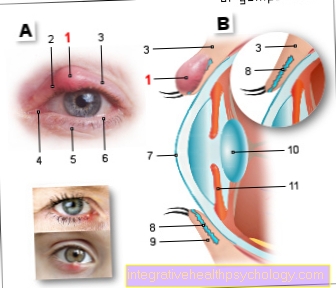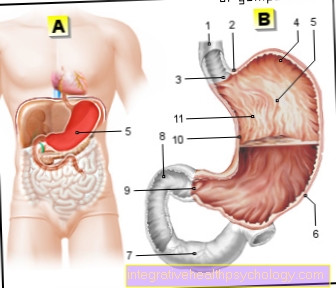Surgery: what is it?
Definition surgery
The surgery (from the Greek: the craftsmanship) is a branch of medicine.
It deals with the diseases or injuries that are treated surgically. Surgery belongs to the operative areas of medicine and is not the only subject in which operations are performed.
Further operational medicine subjects are:
- the orthopedics
- the gynecology
- ear, nose and throat medicine
- ophthalmology
- the urology
- neurosurgery
- cardiac surgery
- and pediatric surgery.

The surgery
The operations represent only part of the work of a surgeon. There are certainly so-called "conservative", i.e. non-operative, types of treatment in surgery.
Furthermore, numerous "minimally invasive" therapy options are available today. E.g. Vessels can be enlarged, parts implanted and entire abdominal operations can only be performed using punctures or very small incisions ("keyhole technique").
Many broken bones (fractures) are also treated without surgery; the application of a plaster splint, for example, is also part of the surgical therapy.
The surgical patients are admitted, examined, advised and informed about the respective operation by surgeons. They carry out the treatment even if it is not surgical.
All accompanying examinations are also carried out or at least arranged by surgeons. Visits to the surgical wards take place daily. Finally, the surgeons prepare and plan patient discharges.
Cardiac surgery, neurosurgery, pediatric surgery, maxillofacial surgery and plastic surgery are independent specialist areas in Germany.
A Specialist in surgery therefore does not have the qualification to perform operations in these areas.
Sub-areas of surgery

The following specializations can be completed as additional qualifications as part of a surgical training by a surgeon.
- Vascular surgery
Vascular surgery deals with the surgical treatment of blood vessels. In the case of vascular constrictions, dilatation measures can be taken, in the case of vascular occlusions bypasses are often created, pathological dilatations of the vessels are treated by implanting prostheses or inserting stents.
- Thoracic surgery
Thoracic surgery includes surgical treatment options for diseases or injuries in the thoracic area. Tumors or other pathological changes in the lungs or in the mid-thoracic region can be removed; if blood or air accumulates in the gap between the lungs and chest wall, drains are placed. The heart is located in Rib cage, is treated surgically not by the thorax, but by the cardiac surgeon.
- Trauma surgery
Trauma surgery treats the consequences of accidents and injuries to the musculoskeletal system, as well as internal organs and parts of the nervous system. Broken bones are the most common type of injury that trauma surgeons treat. In many cases, treatment with a splint (nowadays not only made of plaster of paris) is sufficient, but often an operation cannot be avoided. Nails, plates, wires and screws can be used here to stabilize the fracture, as well as entire joint or even bone prostheses.
- Visceral surgery (synonym: abdominal surgery)
Abdominal organs, thyroid and parathyroid glands, as well as inguinal and abdominal wall hernias are treated in visceral surgery. The organs of the entire gastrointestinal system belong to the treatment area of visceral surgery, even if the esophagus located in the chest. liver, spleen, pancreas and adrenal glands are also operated on by the visceral surgeon. Visceral surgery therefore also includes liver transplant surgery, pancreas and partially the kidney.
History of surgery

There is credible evidence that surgical treatments were carried out as far back as ancient times.
Already in Roman Empire there were instruments that were specially made for surgical procedures. Until surgery was introduced as an academic subject in medicine, Bathers Treated minor injuries, as well Amputations performed.
The first big step was achieved with the introduction of disinfection. At this time, many injured people were being treated - especially in war situations - and the disinfection of the wounds brought decisive successes which further strengthened the position of this type of treatment in society.
With the introduction of the anesthesia In the middle of the 19th century, surgical treatment was significantly advanced. Operations that had previously not been possible due to the enormous pain suffered by the patients became possible very quickly. Many surgeons therefore consider anesthesia to be one of the most important inventions in medicine.
Most of the surgical techniques used today were developed in the 20th century. The advancement of modern surgery is related to the overall development of science and technology. At the end of the 80s of the last century, the minimally invasive surgery introduced. Thanks to keyhole technology, many operations are now possible that previously could only be carried out with much greater effort. In vascular surgery, prostheses were developed in the 1990s, which in some cases can save the patient very large operations.
Like all medicine, surgery is in a constant state of development. It is believed that knowledge in medicine doubles every 2 years.
This development is reflected in surgery, so that further breathtaking achievements in operative medicine can be expected in the future.
Training as a surgeon
Training as a specialist in surgery begins after studying medicine (minimum period of study: 6 years) if the job search in a surgical clinic is successful.
The training to become a specialist takes z. Currently 5 years. During this time, an operation catalog must be completed. The completion of the training in Germany is an oral examination in the respective state medical association.
The training regulations are constantly changing. A shortened period of only basic surgical knowledge is likely to be introduced soon. Then the specialization in a sub-area of surgery should take place. However, this reform will certainly not be the last.
Surgical diseases
The most important diseases from the field of surgerythat you can already find with us can be found below.
All the topics of surgery that we have already published can be found at Surgery A-Z.
Major diseases of surgery
Pancreatic kebabs
Of the Pancreatic cancer = pancreatic cancer (ductal adenocarcinoma of the pancreas) is by far the most common cancer of the pancreas. It belongs to the malignant neoplasms (neoplasms). Benign tumors (including the serous cystadedom) or other malignant forms (mucinous cystadenocarcinoma, acinar cell carcinoma) are very rare.
The pancreatic cancer usually occurs in the front area, the so-called head of the pancreas (see anatomy of the pancreas (pancreas)).
Further information on this topic is available at: Pancreatic cancerIntestinal kebs
Of the Colon cancer is a vicious Degenerate, uncontrollably growing tumor that emerges from the cells of the colon mucosa.
In most cases, colon cancer develops in the colon area.
Further information can be found under our topic: Colon cancer.Varicose veins (varices)
Under Varicose veins, which are called varices in medical jargon, are superficial veins that are sack-shaped or cylindrical.
This phenomenon usually occurs on the legs. It can be primary from secondary Varicose veins can be distinguished.
To primary Varicose veins This is the case when there is no underlying disease, while secondary varicose veins (varices) always have a previous disease as the cause.
Further information can be found under our topic: Varicose veinsInguinal hernia
The inguinal hernia, like all abdominal wall hernias, is a protrusion of contents from the abdominal cavity.
For anatomical reasons, the groin is a place in which 'fractures' occur particularly often, as there are natural weak points in the connective tissue. You can find more on this topic on our website Inguinal hernia.Stomach cancer
Stomach cancer (gastric cancer) is the fifth most common cancer in women and the fourth most common in men. Gastric carcinoma is a malignant, uncontrollably growing tumor that originates from the cells of the gastric mucosa.
The causes of stomach cancer include nitrosamines from food, nicotine and Helicobacter pylori discussed. In most cases, the tumor causes symptoms late, when it is already well advanced.Due to the late diagnosis, stomach cancer is often treated late, so that this type of cancer has a very poor prognosis for the patient.
Further information is available under our topic: Stomach cancerGoiter
The term "goiter" (from the Latin struma "gland swelling", pl. Strumae) or goiter denotes an enlargement of the thyroid.
Goiter has an essential cause in iodine deficiency, which is why goiter is found especially in iodine-deficient areas such as the Alps.
Further information on this topic can be found at: Goiter
What are the typical surgeon's instruments?
A surgeon uses a variety of instruments to perform an operation. Most procedures require a scalpel to cut through the skin and various types of forceps. Fine scissors are often used to prepare the tissue structures and expose the surgical area. Various utensils such as hooks or ratchets are used to move tissue to the side in order to expose deeper structures. Electric current is often used during the operation, which is given off in a targeted manner via a fine metal probe. In this way, tissue structures can be severed or small blood vessels can be closed. Depending on the type of operation, a variety of other typical instruments can be used. For example, in a keyhole surgery, the surgeon uses various types of fine grasping forceps to expose and manipulate the surgical site.
scalpel
A scalpel is a fine and extremely sharp knife that is used in surgery to cut through tissue sharply. In an operation, it is mainly needed at the beginning to cut through the skin. In contrast, deeper-lying structures are usually cut by blunt exposure with tweezers and the targeted use of electrical current. With scalpels used today, the scalpel blades are discarded after use and only the scalpel handle is reused after being cleaned aseptically with a new blade.
scissors
Scissors are essential in most surgeries. For one thing, surgeons often use them to cut tissue or to expose structures. On the other hand, scissors are required to cut through the material used. For example, if a severed blood vessel is tied with a thread, you need scissors to cut off the ends of the thread. Scissors are also required to cut the threads when sewing the various layers of the wound.
Clamps
Clamps are instruments widely used in operations. They come in a variety of designs and sizes, and accordingly the surgeon uses them for a variety of purposes. In general, they are used to hold and fix organic tissue or material. During various operations, a clamp can be used, for example, to temporarily close a blood vessel to prevent blood from escaping into the operating area. The vessel can then be knotted with a thread, for example, and thus finally closed and the clamp removed again. Other structures such as the intestine are also temporarily clamped off during some operations. In addition, other utensils used in the operating room such as tapes or towels can be fixed in their position with a clamp.





























